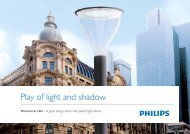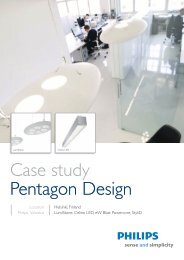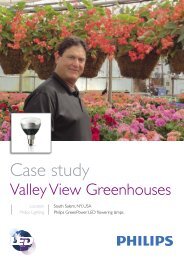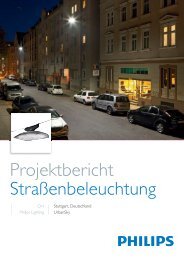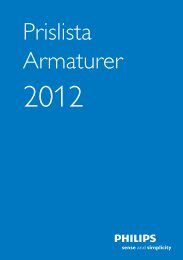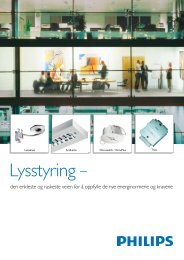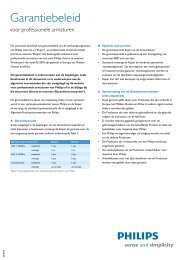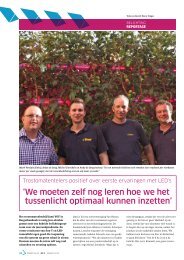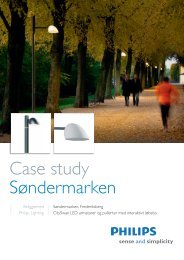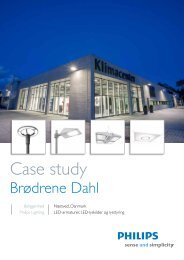intelligent lighting for smart and livable cities - Philips Lighting
intelligent lighting for smart and livable cities - Philips Lighting
intelligent lighting for smart and livable cities - Philips Lighting
Create successful ePaper yourself
Turn your PDF publications into a flip-book with our unique Google optimized e-Paper software.
020 inDUstRY intRODUCtiOn inDUstRY intRODUCtiOn 021<br />
IntellIgent lIghtIng<br />
<strong>for</strong> <strong>smart</strong> <strong>and</strong><br />
lIvable cItIes<br />
erIc rondolat, CEO, PhiliPs <strong>lighting</strong><br />
a<br />
century ago, less than 10 per cent of the<br />
world’s population lived in <strong>cities</strong>. By the<br />
start of the 21st century this figure had<br />
risen to over 50 per cent, <strong>and</strong> by 2050<br />
over two thirds of us will be living in <strong>cities</strong>. Faced with<br />
this rapid urbanisation, municipal authorities<br />
recognise the need to create safe, <strong>smart</strong>, vibrant <strong>and</strong><br />
environmentally sound city environments. Intelligent,<br />
energy-efficient <strong>lighting</strong> can help them achieve this<br />
ambition. But there is no time to lose.<br />
urbanIsatIon – opportunIty<br />
<strong>and</strong> challenge<br />
Many of the new city dwellers can be found in<br />
emerging economies like China, India <strong>and</strong> Africa,<br />
where conurbations of over 10 million inhabitants<br />
are becoming increasingly prevalent. At the same<br />
time, <strong>cities</strong> in developed regions like Europe <strong>and</strong><br />
North America are having to adapt, as the postindustrial<br />
age <strong>and</strong> accompanying shift toward a<br />
service economy change the very nature of city<br />
life. Furthermore, advances in human development<br />
<strong>and</strong> public health have resulted in a global<br />
population that is living longer.<br />
Urban growth <strong>and</strong> trans<strong>for</strong>mation on this scale<br />
offers tremendous opportunities <strong>for</strong> economic <strong>and</strong><br />
social development, but also presents huge<br />
challenges, especially in these times of financial<br />
<strong>and</strong> resource constraints. Quality of life (citizens’<br />
health <strong>and</strong> well-being), the promotion of commerce<br />
<strong>and</strong> tourism, <strong>and</strong> historic preservation are all high<br />
on municipal agendas. At the same time, towns<br />
<strong>and</strong> <strong>cities</strong> are keen to reduce their ecological<br />
impact: urban environments contribute heavily to<br />
the dem<strong>and</strong> <strong>for</strong>, <strong>and</strong> cost of, energy, while also<br />
affecting the balance of nature through (light)<br />
pollution <strong>and</strong> waste.<br />
“ today, cItIes<br />
consume over 70<br />
per cent of the<br />
world’s energy<br />
supply, a fIgure<br />
that wIll only<br />
Increase over<br />
tIme<br />
”<br />
Pictured above: User<br />
interface of CityTouch<br />
online outdoor <strong>lighting</strong><br />
management system<br />
Main: Dynamic LED<br />
<strong>lighting</strong> of the Gr<strong>and</strong><br />
Canal, Hangzhou, China<br />
IntellIgent lIghtIng<br />
As a leading innovator in the field of health <strong>and</strong> wellbeing,<br />
with a mission to improve the quality of life<br />
through meaningful innovations <strong>and</strong> the vision to<br />
strive <strong>for</strong> a healthier <strong>and</strong> more sustainable world,<br />
<strong>Philips</strong> is committed to providing <strong>intelligent</strong> peoplefocused<br />
solutions that help build truly <strong>livable</strong> <strong>cities</strong>.<br />
As <strong>lighting</strong> goes digital, we are incorporating our<br />
innovative LED light sources, luminaires, <strong>smart</strong><br />
<strong>lighting</strong> controls <strong>and</strong> software in fully integrated,<br />
<strong>intelligent</strong> solutions <strong>for</strong> <strong>cities</strong>. Intelligent <strong>lighting</strong><br />
provides the right amount of light precisely where it is<br />
needed <strong>and</strong> when it is needed. This enables municipal<br />
authorities to save energy <strong>and</strong> maintenance costs <strong>and</strong><br />
to reduce obtrusive light, while making urban spaces<br />
safer <strong>and</strong> more attractive, thus strengthening city<br />
br<strong>and</strong>ing. Instead of continuously replacing lamps <strong>and</strong><br />
components, product delivery will increasingly be<br />
directed towards software <strong>and</strong> controllability, thereby<br />
adding new value through improved <strong>lighting</strong> services.<br />
energy effIcIency<br />
Today, <strong>cities</strong> consume over 70 per cent of the world’s<br />
energy supply, a figure that will only increase over time.<br />
Going <strong>for</strong>ward, how will these <strong>cities</strong> manage to meet<br />
the growing dem<strong>and</strong> <strong>for</strong> energy while keeping costs<br />
under control?<br />
<strong>Lighting</strong> accounts <strong>for</strong> 19 per cent of the world’s<br />
electricity consumption, with some 60 per cent of<br />
this used by commercial <strong>and</strong> public buildings in<br />
<strong>cities</strong>, <strong>and</strong> around 15 per cent by street <strong>lighting</strong>.<br />
Significant savings are possible – on average 40 per<br />
cent – simply by switching to energy-efficient<br />
<strong>lighting</strong> technologies such as LED. On a global level<br />
the potential savings amount to €128 billion in<br />
reduced electricity cost <strong>and</strong> 670 million tonnes<br />
of CO 2 , or the equivalent of 642 power plants.<br />
<strong>Philips</strong> is driving the <strong>lighting</strong> industry’s transition<br />
toward energy-efficient <strong>lighting</strong>, <strong>and</strong> we aim<br />
to improve the energy efficiency of all the products<br />
we bring to market by 50 per cent in the period<br />
2010-2015.<br />
InnovatIng future-proof<br />
solutIons<br />
Together with a range of strategic partners from both<br />
the public <strong>and</strong> private sector, we are constantly working<br />
on innovative, integrated <strong>lighting</strong> solutions to help<br />
build <strong>intelligent</strong>ly connected <strong>cities</strong>. Our CityTouch<br />
online outdoor <strong>lighting</strong> management system is a case<br />
in point.<br />
With steeply rising urban populations, it is clear<br />
that static, passive streetlights simply cannot keep<br />
pace with the lives we lead. Livable <strong>cities</strong> require<br />
<strong>lighting</strong> that can adjust to the ebb <strong>and</strong> flow of traffic<br />
<strong>and</strong> urban activity. CityTouch enables dynamic,<br />
<strong>intelligent</strong> <strong>and</strong> flexible control of <strong>lighting</strong> city-wide.<br />
Combined with LED-based fixtures, it can save up<br />
to 70 per cent on energy <strong>and</strong> maintenance costs<br />
compared to conventional <strong>lighting</strong>.<br />
CityTouch allows users to manage all the <strong>lighting</strong><br />
systems <strong>for</strong> an entire city from a single, intuitive<br />
online user interface. It provides easy, streamlined<br />
maintenance <strong>and</strong> oversight, with real-time status<br />
reports <strong>for</strong> each individual light point. Moreover, by<br />
making it possible to dim light points outside of<br />
peak hours, detect failures <strong>and</strong> provide <strong>smart</strong><br />
<strong>lighting</strong> workflow support, the system significantly<br />
reduces operating costs <strong>and</strong> energy usage – leading<br />
to lower energy bills, lower carbon emissions <strong>and</strong><br />
less light pollution.<br />
CityTouch also protects the city’s infrastructure<br />
investment by adjusting seamlessly to new<br />
technologies <strong>and</strong> evolving needs. As they exp<strong>and</strong>,<br />
<strong>cities</strong> using CityTouch can simply add new streets to<br />
the existing network. New <strong>lighting</strong> functionalities<br />
can also be easily incorporated. Also, CityTouch is<br />
the first control plat<strong>for</strong>m that is not bound to one<br />
hardware type or provider. This means that users<br />
have flexibility in choosing the products that best<br />
suit their city’s requirements <strong>and</strong> budget – secure in<br />
the knowledge that their light points will work<br />
seamlessly with the CityTouch system.
InspIrIng envIronments<br />
In addition to their capacity to slash energy bills <strong>and</strong><br />
avoid greenhouse gas emissions, our integrated LEDbased<br />
<strong>lighting</strong> solutions offer exceptional freedom in<br />
terms of controlled <strong>lighting</strong> effect (colour, dynamics)<br />
<strong>and</strong> design. This capability is driving a shift<br />
from “quantitative” functional <strong>lighting</strong> towards<br />
“qualitative” <strong>intelligent</strong> <strong>and</strong> emotive <strong>lighting</strong> that<br />
trans<strong>for</strong>ms urban environments, offering city<br />
residents <strong>and</strong> visitors safety <strong>and</strong> spectacle, uplifting<br />
<strong>and</strong> inspiring experiences.<br />
whIte lIght <strong>for</strong> safer streets<br />
To hold on to both their private <strong>and</strong> corporate<br />
citizens, <strong>cities</strong> must provide safer streets <strong>for</strong> both<br />
motorists <strong>and</strong> pedestrians. <strong>Lighting</strong> can make a<br />
decisive contribution in this regard. For example, at<br />
the same light level, more than 80 per cent of<br />
people feel safer with bright white light than with<br />
traditional street-<strong>lighting</strong> solutions. The closest<br />
approximation to actual sunlight, white light is<br />
considered to be more authentic <strong>and</strong> com<strong>for</strong>table:<br />
its high levels of perceived brightness <strong>and</strong> superior<br />
Pictured above: Dynamic<br />
LED <strong>lighting</strong> of Miami<br />
Tower, USA<br />
Far right: Eric Rondolat,<br />
CEO of <strong>Philips</strong> <strong>Lighting</strong><br />
“ there are<br />
Indeed many<br />
sIgnIfIcant<br />
challenges<br />
to be overcome,<br />
yet the prospect<br />
of safe, vIbrant,<br />
eco-frIendly<br />
cItIes Is no<br />
IllusIon<br />
”<br />
Photo by New York Focus<br />
colour rendering help people feel safer <strong>and</strong> make it<br />
easier to distinguish objects, colors, shapes <strong>and</strong><br />
other details.<br />
At Rio+20 a report entitled <strong>Lighting</strong> the Clean<br />
Revolution: The rise of LEDs <strong>and</strong> what it means <strong>for</strong><br />
<strong>cities</strong> (www.TheCleanRevolution.org/<strong>lighting</strong>-theclean-revolution)<br />
was published, outlining the<br />
findings of LightSavers – an independent global<br />
pilot of LED lamps across 12 of the world’s largest<br />
<strong>cities</strong>. These findings included the fact that a large<br />
majority of residents of pilot <strong>cities</strong> reported<br />
improved visibility <strong>and</strong> felt safer with LED-based<br />
white light.<br />
effectIve Image buIldIng<br />
Quite simply, high-quality <strong>intelligent</strong> <strong>lighting</strong> helps<br />
make a city safer <strong>and</strong> more attractive, enhancing its<br />
br<strong>and</strong> identity – the distinctive signature that<br />
defines its appeal <strong>and</strong> differentiates it from other<br />
<strong>cities</strong>. This is important not only <strong>for</strong> civic pride, but<br />
also to attract new residents, new businesses <strong>and</strong><br />
inward investment that boost retailing, tourism <strong>and</strong><br />
other boosts to economic growth <strong>and</strong> employment.<br />
need to act... <strong>and</strong> act fast!<br />
The <strong>intelligent</strong>ly connected, energy-efficient <strong>lighting</strong><br />
solutions we need <strong>for</strong> a sustainable future are here<br />
today – the one thing we cannot af<strong>for</strong>d is to delay<br />
their implementation. The current rate of renovation<br />
of existing infrastructure based on outdated,<br />
inefficient technology is simply too slow. We urge<br />
governments worldwide to act – by creating policy<br />
frameworks (governing, <strong>for</strong> instance, public<br />
procurement, Total Cost of Ownership, <strong>and</strong> fiscal<br />
incentives) that stimulate clean, <strong>smart</strong> innovation,<br />
<strong>and</strong> adopting more ambitious energy <strong>and</strong> resource<br />
efficiency per<strong>for</strong>mance st<strong>and</strong>ards. At the same<br />
time, they can lead by example by making their own<br />
public buildings, schools <strong>and</strong> streets <strong>smart</strong> <strong>and</strong><br />
energy-efficient.<br />
Such top-down change must be complemented by a<br />
bottom-up, sectoral approach, in which the business<br />
community <strong>and</strong> public stakeholders join <strong>for</strong>ces in<br />
new public-private partnerships to accelerate the<br />
market penetration of innovative new technologies,<br />
products <strong>and</strong> services. Here too, our <strong>lighting</strong><br />
industry provides a good example. Inspired by<br />
<strong>Philips</strong>’ leadership, the industry is working together<br />
to drive the global switch to energy-efficient <strong>lighting</strong>.<br />
In addition, the en.lighten public/private partnership<br />
between UNEP, the Global Environmental Facility,<br />
<strong>Philips</strong>, Osram <strong>and</strong> NLTC to promote the adoption<br />
of efficient <strong>lighting</strong> in developing <strong>and</strong> emerging<br />
countries, has created a virtual global sectoral<br />
market transition. This sectoral <strong>lighting</strong> industry<br />
inDUstRY intRODUCtiOn 023<br />
approach also constitutes a welcome bottom-up<br />
contribution to the UNFCCC’s ambitions to make<br />
progress on tackling Climate Change at COP18 in<br />
Qatar.<br />
From a sustainability viewpoint we could also<br />
benefit greatly by moving financing mechanisms<br />
from ‘lowest price tag’ to ‘life-cycle value’. This<br />
involves advancing new business models that<br />
balance operating expense <strong>and</strong> capital expenditure.<br />
For example, CityTouch’s “fee per light point per<br />
month” approach eliminates the need <strong>for</strong> upfront<br />
investment. The savings in energy <strong>and</strong> maintenance<br />
costs that are enabled by CityTouch can lead to<br />
best-in-class payback times of the investments in<br />
new energy-efficient <strong>lighting</strong>.<br />
lookIng <strong>for</strong>ward<br />
There are indeed many significant challenges to be<br />
overcome, yet the prospect of safe, vibrant, ecofriendly<br />
<strong>cities</strong> is no illusion. We can achieve this.<br />
With a <strong>for</strong>ward-looking agenda <strong>and</strong> a commitment<br />
to partnering with other change agents in both the<br />
private <strong>and</strong> public sectors, we at <strong>Philips</strong> are resolved<br />
to play our part – by continuing to deliver the<br />
<strong>intelligent</strong> <strong>lighting</strong> solutions that will help create the<br />
sustainable <strong>livable</strong> <strong>cities</strong> of the future n<br />
about the author<br />
Eric Rondolat has been the CEO of <strong>Philips</strong> <strong>Lighting</strong><br />
since April 2012. He began his career with Merlin<br />
Gerin in 1990, <strong>and</strong> from there he started a longterm<br />
international career within Schneider Electric<br />
in both mature as well as fast-developing emerging<br />
markets. Mr Rondolat holds an Engineering degree<br />
<strong>and</strong> a Master’s degree in International Marketing.



